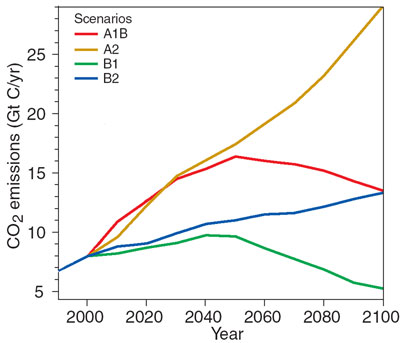 > ENC Master > Climate Encyclopaedia > People changing climate > more > 2. How will future be? > - Future emissions
> ENC Master > Climate Encyclopaedia > People changing climate > more > 2. How will future be? > - Future emissions
 |
|
|
|
people changing the climate? |
2. What will
|
Driving forces
ScenariosWe cannot know for sure how these driving forces of climate change will look in the future – but we can guess. Scientists at IPCC have constructed four very different pictures of the future, or scenarios as they are also called, to represent changes in population size, affluence, use of energy sources, and energy technology up to the year 2100. All four scenarios describe a possible future development: A1B – a rich world
A2 – a heterogeneous world
B1 – a sustainable world
|
|
For each of these very different future scenarios, scientists have estimated what the emissions would be. These emissions figures are then entered into climate models to calculate how the concentrations of greenhouse gases, temperature, sea level, and climate will be changed in each of the scenarios. These scenarios are what the IPCC used to come up with the figure of a temperature increase between 1.4 and 5.8°C by the year 2100. To ensure that all reasonable future developments have been taken into account, they have used about 40 variations of the four scenarios – where they made smaller changes in the demographics, economic growth or energy consumption estimates, and used different economic models. The reason for the large difference between the highest and lowest temperature estimates is partly that there is some uncertainty about how exactly the climate system works, and partly that we cannot know precisely what the future holds in terms of social developments and emissions patterns. The IPCC says that for every emissions scenario there is a 40% chance that the temperature change will be greater than indicated, but only a 5% likelihood that it will be less. These scenarios do not take into account the possibility of countries implementing new, comprehensive measures for reducing emissions of greenhouse gases. If that happens, then both the emissions and warming can be reduced.
|
|
Back to Basics-section
Author: Camilla Schreiner - CICERO (Center for International Climate and Environmental Research - Oslo) - Norway. Scientific reviewers: Andreas Tjernshaugen - CICERO (Center for International Climate and Environmental Research - Oslo) - Norway - 2004-01-20 and Knut Alfsen - Statistics Norway - Norway - 2003-09-12. Educational reviewer: Nina Arnesen - Marienlyst school in Oslo - Norway - 2004-03-10. Last update: 2004-03-27.
|

